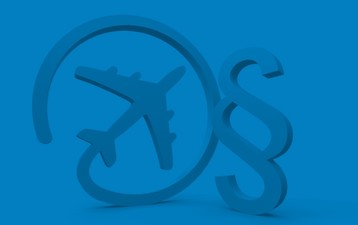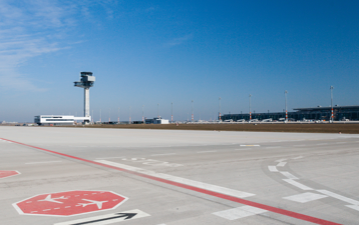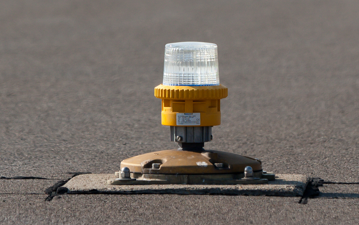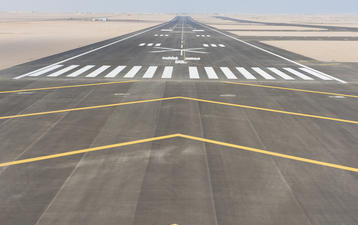Aviation Law for Aerodromes
Aerodromes operate within a complex and detailed set of supranational and/or national regulations defined by various State-bodies like ICAO, EASA as well as industry stakeholders like ACI or IATA. These are the foundation of any domestic legal system.
In order to obtain and keep the operator’s certificate as well as to provide safe and efficient infrastructure and operational services a thorough, comprehensive and deep understanding of the legal environment, its mechanics and dynamics as well as their application into the local requirements and means at an aerodrome are existential for any planner, operator, manager and Authority.
In this high intensity three-day training, participants will receive a comprehensive overview of the fundamentals of international aviation law, regulatory frameworks, international bodies (such as ICAO, IATA and ACI) and their requirements, and strengthen their knowledge through industry case studies and practical discussions.
International law needs to be integrated into national legislation. Different countries interpret and incorporate international law in different ways. European Law is directly applicable and binding in all member states. Participants will learn about European aviation law as well as the structure and rulemaking procedures of the European Union. The course will provide participants with a sound understanding of the European framework regulation where common rules and essential requirements are laid out in a Basic Regulation (Regulation (EU) 2018/1139) and the more detailed technical specifications are described within implementing regulations.
Practical examples (if preferred: participants’ specific challenges) are used to familiarise the participants with the most important legal aspects related to aerodrome planning and operation. The course is aimed at airport planners and managers, airport operators, architects and employees of State Authorities who are required to have competence in the interpretation and application of aviation law. It is a basic course for which no prior knowledge is required.
Course Details
Location:BerlinLanguage:English
Date:26.11. - 28.11.2025
Duration:3 days
Provider:airsight GmbH
Course Fee
For courses in Berlin:
All customers will be charged 19% VAT. For more information please see our About Taxes page.
The final price will be shown on your invoice.
Please note: If you want to register several particpants from your company but need a single invoice for each, please register each of them seperately.
Course Content
Introduction
- Stakeholders and Operating Partners in Aviation
- Interdependencies, interfaces and responsibilities
- Regulatory bodies
- Operating partners
UN & International Civil Aviation Organisation (ICAO)
- ICAO
- Annex 14 – Aerodromes
- Guidance material and manuals
- ICAO Doc 9157 Aerodrome Design Manual
- ICAO Doc 9137 Aerodrome Services Manual
- ICAO Doc 9981, PANS Aerodrome
- International bodies and regulatory framework
- International Air Transport Association (IATA)
- Airports Council International (ACI)
- Others (JIG, SAE)
European Union & EASA
- Regulatory bodies and airport-specific EU regulations
- EASA Basic Regulation (Regulation (EU) 2018/1139)
- Essential requirements for the planning and operation of an aerodrome
- Rules for Aerodromes (Regulation (EU) No 139/2014)
- Implementing Rules (IR)
- Acceptable Means of Compliance (AMC) and Guidance material (GM)
- Certification Specifications (CS)
- Implementing Rules and delegated acts for aerodromes
- EASA Certification
- EASA flexibility tools
- Deviation Acceptance and Action Documents (DAAD)
- Equivalent level of safety (ELOS)
- Special conditions (SC)
- Alternative means of Compliance (AltMoC)
- Relevant amendments:
- EU airport noise (Regulation (EU) 598/2014)
- Runway safety and aeronautical data (Regulation (EU) 2020/2148)
- Apron Management Services, AMS (Regulation (EU) 2020/1234)
- Classification of runways (Regulation (EU) 2018/481)
Aerodrome Certification
- Applicable regulatory regime
- Certification process
- Organisation (incl. SMS and Qualification)
- Operations
- Infrastructure
- Planning parameters
- Certification Base
- Maintenance
- Upholding the Certificate
- Oversight
- Contractual regime
- Documents of proof
- Responsibilities
Trainer
Martin Lenke
Martin is a seasoned aerodrome expert with more than 30 years of experience in concepting, planning, developing, operating and managing aerodromes as well as areas like ORAT, training or certification.
As a qualified lead auditor from IATA, accredited expert and facilitator for ICAO and IATA, he has conducted consulting and training projects around the globe and has lead aerodrome certification projects for some 15 airports.
Martin is an Aeronautical Engineer with a German Diploma from Berlin University, holds a Master’s Degree in Air Transport from Cranfield University and is a certified organisational advisor and coach. In his former professional responsibilities he acted as State aviation supervisor, Federal aircraft accident investigator (airports) and managed Frankfurt International’s airside operations and infrastructure.
Target Group
- Aerodrome designers, engineers, planners and operators
- Civil Aviation Authorities personnel
- Architects and civil engineers
- Governmental organisations and agencies
Course Location
Participants are responsible for making their own travel arrangements. The accommodation and travel costs are at the charge of the participants. Please note that airsight does not perform any travel and hotel bookings for the participants. Rooms can however be booked directly by the participants by contacting the hotel. We would like to point out that from January 2025 a City Tax of 7.5% will be imposed on overnight stays for business and professional purposes in Berlin.
The course fee includes the registration, training material and examination. For non-virtual courses, coffee breaks and business lunch are also included.
Organisational Details
The course hours are scheduled as follows:
first training day: 10:00 am - 5:00 pm
mid-training days: 9:00 am - 5:00 pm
last training day: 8:00 am - 4:00 pm
Coffee breaks and business lunch are included in the course fee. At the end of the course, all participants will receive an airsight certificate based on EASA training regulations, which is highly recognised throughout the aviation industry.
About airsight Training
airsight Training course quality
airsight operates an ISO 9001 certified Quality Management System and pursues the objective to provide high quality services that fully meet the clients’ needs.
Course Details
Location:In-houseLanguage:German / English
Duration:2 days
Provider:airsight GmbH
Course Content
Introduction
- Stakeholders and Operating Partners in Aviation
- Interdependencies, interfaces and responsibilities
- Regulatory bodies
- Operating partners
UN & International Civil Aviation Organisation (ICAO)
- ICAO
- Annex 14 – Aerodromes
- Guidance material and manuals
- ICAO Doc 9157 Aerodrome Design Manual
- ICAO Doc 9137 Aerodrome Services Manual
- ICAO Doc 9981, PANS Aerodrome
- International bodies and regulatory framework
- International Air Transport Association (IATA)
- Airports Council International (ACI)
- Others (JIG, SAE)
European Union & EASA
- Regulatory bodies and airport-specific EU regulations
- EASA Basic Regulation (Regulation (EU) 2018/1139)
- Essential requirements for the planning and operation of an aerodrome
- Rules for Aerodromes (Regulation (EU) No 139/2014)
- Implementing Rules (IR)
- Acceptable Means of Compliance (AMC) and Guidance material (GM)
- Certification Specifications (CS)
- Implementing Rules and delegated acts for aerodromes
- EASA Certification
- EASA flexibility tools
- Deviation Acceptance and Action Documents (DAAD)
- Equivalent level of safety (ELOS)
- Special conditions (SC)
- Alternative means of Compliance (AltMoC)
- Relevant amendments:
- EU airport noise (Regulation (EU) 598/2014)
- Runway safety and aeronautical data (Regulation (EU) 2020/2148)
- Apron Management Services, AMS (Regulation (EU) 2020/1234)
- Classification of runways (Regulation (EU) 2018/481)
Aerodrome Certification
- Applicable regulatory regime
- Certification process
- Organisation (incl. SMS and Qualification)
- Operations
- Infrastructure
- Planning parameters
- Certification Base
- Maintenance
- Upholding the Certificate
- Oversight
- Contractual regime
- Documents of proof
- Responsibilities
Trainer
Dr. iur. Chehab Salih
Chehab holds a Doctor of Laws degree from the University of Potsdam and is specialised in International Aviation Law. Within his dissertation, he discussed legal questions that arise during the demonstration of compliance at aerodromes, also focusing on challenges states face when international requirements are integrated into national legislation.
An expert in airport operations and safety analyses, Chehab holds a Master’s degree in Aeronautical and Astronautical Engineering from the Technical University of Berlin, with a focus on air traffic control procedures, flight operations, airport planning, and aerodynamics. Chehab has wide ranging global experience in assisting airports in developing innovative operational concepts for safe and efficient airside operations. This knowledge was gained during numerous audits and trainings he conducted on a worldwide basis. In addition, he focuses on various national research projects, for example for the German Ministry of Transport introducing SERA regulations in Germany (IFR flight operations in airspace G).
At airsight, Chehab is responsible for the conduction of aeronautical studies with regards to aerodrome operations, air traffic control, and airport planning, including numerous compliance check studies and analyses of threats regarding implementation of new wind turbines in aerodrome vicinity. Further, Chehab is responsible for aerial service at airsight, focusing on operations of drones at aerodromes. Currently, Chehab is supporting Changi airport during the conduction of the pilot safety case aiming to prove the safe introduction of the 3rd runway.
Target Group
- Aerodrome designers, engineers, planners and operators
- Civil Aviation Authorities personnel
- Architects and civil engineers
- Governmental organisations and agencies
Organisational Details
airsight offers this training course on request, worldwide. At the end of the course, all participants will receive an airsight certificate based on EASA training regulations, which is highly recognised throughout the aviation industry.
About airsight Training
airsight Training course quality
airsight operates an ISO 9001 certified Quality Management System and pursues the objective to provide high quality services that fully meet the clients’ needs.


 Training 5 or more people? Ask for an In-house course at your premises or online!
Training 5 or more people? Ask for an In-house course at your premises or online!


